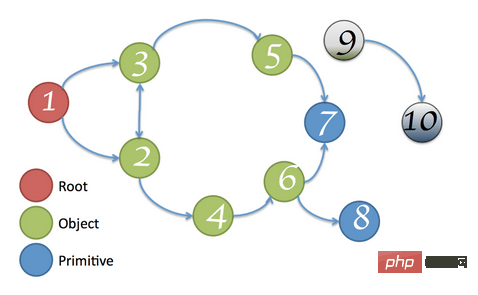What is memory in javascript
In JavaScript, memory usually refers to the memory space divided (abstracted) by the operating system from the main memory. Memory can be divided into two categories: 1. Stack memory, which is a continuous memory space with a small capacity. It is mainly used to store data such as function call information and variables. A large number of memory allocation operations will cause stack overflow; 2. Heap memory, It is a large memory space. The allocation of heap memory is dynamic and discontinuous. Programs can apply for heap memory space on demand, but the access speed is much slower than stack memory.

The operating environment of this tutorial: windows7 system, javascript version 1.8.5, Dell G3 computer.
JavaScript was born in 1995 and was originally designed for form validation within web pages.
JavaScript has grown rapidly over the years, and its ecosystem has grown day by day, becoming one of the most popular development languages among programmers. And now JavaScript is no longer limited to the web page, but has expanded to the desktop, mobile and server.
With the advent of the big front-end era, more and more developers are using JavaScript, but many developers only stay at the level of "knowing how to use it" and do not have a better understanding of this language. .
If you want to become a better JavaScript developer, understanding memory is a key point that cannot be ignored.
This article mainly contains two parts:
JavaScript memory detailed explanation
JavaScript Memory Analysis Guide
#After reading this article, I believe you will have a comprehensive understanding of JavaScript memory and be able to perform memory analysis on your own.
Memory
What is memory
I believe that everyone has a certain understanding of memory, so I won’t start from the beginning of Pangu, but will mention it a little bit.
First of all, any application cannot run without memory.
In addition, the memory we mentioned has different meanings at different levels.
Hardware level (Hardware)
At the hardware level, memory refers to random access memory.
Memory is an important part of the computer. It is used to store various data required for application operation. The CPU can directly exchange data with the memory to ensure that the application can run smoothly.
Generally speaking, there are two main types of random access memory in a computer: cache (Cache) and main memory (Main memory).
The cache is usually integrated directly inside the CPU and is relatively far away from us, so more often the (hardware) memory we mention is main memory.
? Random Access Memory (Random Access Memory, RAM)
Random access memory is divided into static random access memory (Static Random Access Memory, SRAM) and dynamic random access memory (Dynamic Random Access Memory, DRAM).
SRAM is much faster than DRAM in terms of speed, and the speed of SRAM is second only to the registers inside the CPU.
In modern computers, SRAM is used for cache and DRAM is used for main memory.
? Main memory (Main memory)
Although the cache is very fast, its storage capacity is very small. It ranges from a few KB to a few tens of MB at most, which is not enough to store the data running the application.
We need a storage component with moderate storage capacity and speed that allows us to run dozens or even hundreds of applications at the same time while ensuring performance. This is the role of main memory.
The main memory in the computer is actually what we usually call the memory stick (hardware).
#Hardware memory is not our topic today, so that’s all. If you want to know more about it, you can search according to the keywords mentioned above.
Software level (Software)
At the software level, memory usually refers to the operating system A memory space divided (abstracted) from main memory.
At this time, memory can be divided into two categories: stack memory and heap memory.
Next I will explain memory around the JavaScript language.
The memory mentioned in the following articles refers to the memory at the software level.
Stack & Heap
-
Stack memory
? Stack
The stack is a common data structure. The stack only allows data to be manipulated at one end of the structure. All data All follow the Last-In First-Out (LIFO) principle.
The most appropriate example in real life is the badminton bucket. Usually we only access one side of the bucket. The first badminton put in can only be taken out last, and the last put in can only be taken out. will be taken out first.
The reason why stack memory is called stack memory is because stack memory uses the stack structure.
Stack memory is a continuous memory space. Thanks to the simplicity and directness of the stack structure, the access and operation speed of stack memory are very fast.
The stack memory has a small capacity and is mainly used to store data such as function call information and variables. A large number of memory allocation operations will cause stack overflow.
The data storage in stack memory is basically temporary, and the data will be recycled immediately after use (for example, local variables created within the function will be recycled after the function returns).
Simply put: Stack memory is suitable for storing data with a short life cycle, small footprint and fixed data.

? The size of the stack memory
The stack memory is directly managed by the operating system, so the size of the stack memory The size is also determined by the operating system.
Generally speaking, each thread (Thread) will have an independent stack memory space. The default size of the stack memory allocated by Windows to each thread is 1MB.
Heap memory
? Heap
Heap is also a common data structure, but it is outside the scope of this article, so I won’t say more.
Although heap memory has the word "heap" in its name, it has nothing to do with the heap in the data structure. It just has a name.
Heap memory is a large memory space. The allocation of heap memory is dynamic and discontinuous. Programs can apply for heap memory space on demand, but the access speed is much slower than stack memory.
The data in the heap memory can exist for a long time. Useless data needs to be actively recycled by the program. If a large amount of useless data takes up memory, it will cause a memory leak (Memory leak).
Simply put: Heap memory is suitable for storing data that has a long life cycle, takes up a large space, or occupies an irregular space.
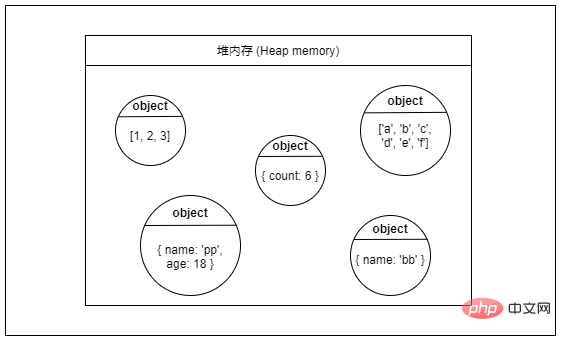
? The upper limit of heap memory
In Node.js, the default upper limit of heap memory is 64 Approximately 1.4 GB on 32-bit systems and 0.7 GB on 32-bit systems.
In Chrome, the memory limit per tab is approximately 4 GB (64-bit systems) and 1 GB (32-bit systems).
? Process, thread and heap memory
Generally speaking, a process (Process) will only have one heap memory. Multiple threads will share the same heap memory.
In the Chrome browser, each tab generally has a separate process, but in some cases multiple tabs share a process.
Function calling
After understanding what stack memory and heap memory are, Now let's see what happens to stack memory and heap memory when a function is called.
When a function is called, the function will be pushed into the stack memory to generate a stack frame. The stack frame can be understood as a block composed of the function's return address, parameters and local variables; When a function calls another function, it will push another function into the stack memory, and the cycle starts again; until the last function returns, the elements in the stack memory will be popped one by one from the top of the stack until there are no more elements in the stack memory. element, this call ends.

The content in the above figure has been simplified, stripping away the concepts of stack frames and various pointers, and mainly showing the general process of function calling and memory allocation.
Under the same thread (JavaScript is single-threaded), all executed functions and function parameters and local variables will be pushed into the same stack memory. This means that a large number of recursions will cause stack overflow. (Stack overflow) reason.
Please read on for details about the memory allocation of internal variables of the functions involved in the figure.
Store variables
When the JavaScript program is running, in the non-global scope Local variables generated in are stored in stack memory.
However, only primitive type variables actually store values in stack memory.
The reference type variable only stores a reference (reference) in the stack memory, and this reference points to the real value in the heap memory.
? Primitive type
Primitive type is also called basic type, including
string,number,bigint,boolean,undefined,null, andsymbol(new in ES6).Values of primitive types are called primitive values.
Supplement: Although
typeof nullreturns'object',nullis really not an object. Such a result is actually a result of JavaScript. Bug~
? Reference type
Except for primitive types, all other types are reference types, including
Object,Array,Function,Date,RegExp,String,Number,Boolean, etc...In fact,
Objectis the most basic reference type, and other reference types inherit fromObject. That is, all reference type values are actually objects.The value of reference type is called reference value.
? Simply put
In most cases, primitive type data is stored in stack memory, while reference type data (object) is stored in heap memory.

Special Attention
Global variables and variables referenced by closures (even primitive types) are stored in heap memory.
? Global variables
All variables created in the global scope will become global objects (such as window objects) Properties are global variables.
Global objects are stored in heap memory, so global variables must also be stored in heap memory.
Don't ask me why global objects are stored in heap memory, I will fall out after a while!
? Closures
Variables created within a function (local scope) are all local variables.
When a local variable is referenced by other functions other than the current function (that is, escape occurs), the local variable cannot be recycled with the return of the current function. , then this variable must be stored in heap memory.
The "other functions" here are what we call closures, just like the following example:
function getCounter() {
let count = 0;
function counter() {
return ++count;
}
return counter;
}
// closure 是一个闭包函数
// 变量 count 发生了逃逸
let closure = getCounter();
closure(); // 1
closure(); // 2
closure(); // 3Closures are a very important and commonly used concept in many programming languages The concept of closure is there. I won’t introduce it in detail here, but I will post an article by Ruan Yifeng.
Learn JavaScript closures: http://www.ruanyifeng.com/blog/2009/08/learning_javascript_closures.html
? Escape Analysis
In fact, the JavaScript engine will use escape analysis to determine whether the variable should be stored in stack memory or heap memory.
Simply put, escape analysis is a mechanism used to analyze the scope of variables.
Immutable and Mutable (Immutable and Mutable)
Two types of variable data will be stored in the stack memory: original value and object reference.
Not only are the types different, but their specific performances in stack memory are also different.
Primitive values
? Primitive values are immutable!
As mentioned earlier: primitive types Data (raw values) are stored directly in stack memory.
⑴ When we define a primitive type variable, JavaScript will activate a memory in the stack memory to store the value of the variable (original value) .
⑵ When we change the value of a primitive type variable, in fact a new memory will be activated to store the new value and the variable will point to the new memory space, instead of changing the value in the original memory.
⑶ When we assign a primitive type variable to another new variable (that is, a copy variable), will also activate a new piece of memory and transfer the source Copy the value in the variable memory to the new memory.

? In short: The original value in the stack memory cannot be changed (immutable) once it is determined.
Comparison of original values (Comparison)
When we compare variables of primitive types, we will directly compare the values in the stack memory, as long as values are equal then they are equal.
let a = '123'; let b = '123'; let c = '110'; let d = 123; console.log(a === b); // true console.log(a === c); // false console.log(a === d); // false
Object references
? Object references are mutable!
As mentioned before : Reference type variables only store a reference to heap memory in the stack memory.
⑴ When we define a reference type variable, JavaScript will first find a suitable place in the heap memory to store the object, and activate it A piece of stack memory to store the object reference (heap memory address) , and finally point the variable to this stack memory.
? So when we access an object through a variable, the actual access process should be:
Variable -> Reference in stack memory -> Heap memory The value of
⑵ 当我们把引用类型变量赋值给另一个变量时,会将源变量指向的What is memory in javascript中的对象引用复制到新变量的What is memory in javascript中,所以实际上只是复制了个对象引用,并没有在What is memory in javascript中生成一份新的对象。
⑶ 而当我们给引用类型变量分配为一个新的对象时,则会直接修改变量指向的What is memory in javascript中的引用,新的引用指向What is memory in javascript中新的对象。

? 总之就是:What is memory in javascript中的对象引用是可以被更改的(可变的)。
对象的比较(Comparison)
所有引用类型的值实际上都是对象。
当我们比较引用类型的变量时,实际上是在比较What is memory in javascript中的引用,只有引用相同时变量才相等。
即使是看起来完全一样的两个引用类型变量,只要他们的引用的不是同一个值,那么他们就是不一样。
// 两个变量指向的是两个不同的引用
// 虽然这两个对象看起来完全一样
// 但它们确确实实是不同的对象实例
let a = { name: 'pp' }
let b = { name: 'pp' }
console.log(a === b); // false
// 直接赋值的方式复制的是对象的引用
let c = a;
console.log(a === c); // true对象的深拷贝(Deep copy)
当我们搞明白引用类型变量在内存中的表现时,就能清楚地理解为什么浅拷贝对象是不可靠的。
在浅拷贝中,简单的赋值只会复制对象的引用,实际上新变量和源变量引用的都是同一个对象,修改时也是修改的同一个对象,这显然不是我们想要的。
想要真正的复制一个对象,就必须新建一个对象,将源对象的属性复制过去;如果遇到引用类型的属性,那就再新建一个对象,继续复制…
此时我们就需要借助递归来实现多层次对象的复制,这也就是我们说的深拷贝。
对于任何引用类型的变量,都应该使用深拷贝来复制,除非你很确定你的目的就是复制一个引用。
内存生命周期(Memory life cycle)
通常来说,所有应用程序的内存生命周期都是基本一致的:
分配 -> 使用 -> 释放
当我们使用高级语言编写程序时,往往不会涉及到内存的分配与释放操作,因为分配与释放均已经在底层语言中实现了。
对于 JavaScript 程序来说,内存的分配与释放是由 JavaScript 引擎自动完成的(目前的 JavaScript 引擎基本都是使用 C++ 或 C 编写的)。
但是这不意味着我们就不需要在乎内存管理,了解内存的更多细节可以帮助我们写出性能更好,稳定性更高的代码。
垃圾回收(Garbage collection)
垃圾回收即我们常说的 GC(Garbage collection),也就是清除内存中不再需要的数据,释放内存空间。
由于What is memory in javascript由操作系统直接管理,所以当我们提到 GC 时指的都是What is memory in javascript的垃圾回收。
基本上现在的浏览器的 JavaScript 引擎(如 V8 和 SpiderMonkey)都实现了垃圾回收机制,引擎中的垃圾回收器(Garbage collector)会定期进行垃圾回收。
? 紧急补课
在我们继续之前,必须先了解“可达性”和“内存泄露”这两个概念:
? 可达性(Reachability)
在 JavaScript 中,可达性指的是一个变量是否能够直接或间接通过全局对象访问到,如果可以那么该变量就是可达的(Reachable),否则就是不可达的(Unreachable)。
上图中的节点 9 和节点 10 均无法通过节点 1(根节点)直接或间接访问,所以它们都是不可达的,可以被安全地回收。
? 内存泄漏(Memory leak)
内存泄露指的是程序运行时由于某种原因未能释放那些不再使用的内存,造成内存空间的浪费。
轻微的内存泄漏或许不太会对程序造成什么影响,但是一旦泄露变严重,就会开始影响程序的性能,甚至导致程序的崩溃。
垃圾回收算法(Algorithms)
垃圾回收的基本思路很简单:确定哪个变量不会再使用,然后释放它占用的内存。
实际上,在回收过程中想要确定一个变量是否还有用并不简单。
直到现在也还没有一个真正完美的垃圾回收算法,接下来介绍 3 种最广为人知的垃圾回收算法。
标记-清除(Mark-and-Sweep)
标记清除算法是目前最常用的垃圾收集算法之一。
从该算法的名字上就可以看出,算法的关键就是标记与清除。
标记指的是标记变量的状态的过程,标记变量的具体方法有很多种,但是基本理念是相似的。
对于标记算法我们不需要知道所有细节,只需明白标记的基本原理即可。
需要注意的是,这个算法的效率不算高,同时会引起内存碎片化的问题。
? 举个栗子
当一个变量进入执行上下文时,它就会被标记为“处于上下文中”;而当变量离开执行上下文时,则会被标记为“已离开上下文”。
? 执行上下文(Execution context)
执行上下文是 JavaScript 中非常重要的概念,简单来说的是代码执行的环境。
如果你现在对于执行上下文还不是很了解,我强烈建议你抽空专门去学习下!!!
垃圾回收器将定期扫描内存中的所有变量,将处于上下文中以及被处于上下文中的变量引用的变量的标记去除,将其余变量标记为“待删除”。
随后,垃圾回收器会清除所有带有“待删除”标记的变量,并释放它们所占用的内存。
标记-整理(Mark-Compact)
准确来说,Compact 应译为紧凑、压缩,但是在这里我觉得用“整理”更为贴切。
标记整理算法也是常用的垃圾收集算法之一。
使用标记整理算法可以解决内存碎片化的问题(通过整理),提高内存空间的可用性。
但是,该算法的标记阶段比较耗时,可能会堵塞主线程,导致程序长时间处于无响应状态。
虽然算法的名字上只有标记和整理,但这个算法通常有 3 个阶段,即标记、整理与清除。
? 以 V8 的标记整理算法为例
① 首先,在标记阶段,垃圾回收器会从全局对象(根)开始,一层一层往下查询,直到标记完所有活跃的对象,那么剩下的未被标记的对象就是不可达的了。

② 然后是整理阶段(碎片整理),垃圾回收器会将活跃的(被标记了的)对象往内存空间的一端移动,这个过程可能会改变内存中的对象的内存地址。
③ 最后来到清除阶段,垃圾回收器会将边界后面(也就是最后一个活跃的对象后面)的对象清除,并释放它们占用的内存空间。

引用计数(Reference counting)
引用计数算法是基于“引用计数”实现的垃圾回收算法,这是最初级但已经被弃用的垃圾回收算法。
引用计数算法需要 JavaScript 引擎在程序运行时记录每个变量被引用的次数,随后根据引用的次数来判断变量是否能够被回收。
虽然垃圾回收已不再使用引用计数算法,但是引用计数技术仍非常有用!
? 举个栗子
注意:垃圾回收不是即使生效的!但是在下面的例子中我们将假设回收是立即生效的,这样会更好理解~
// 下面我将 name 属性为 ππ 的对象简称为 ππ
// 而 name 属性为 pp 的对象则简称为 pp
// ππ 的引用:1,pp 的引用:1
let a = {
name: 'ππ',
z: {
name: 'pp'
}
}
// b 和 a 都指向 ππ
// ππ 的引用:2,pp 的引用:1
let b = a;
// x 和 a.z 都指向 pp
// ππ 的引用:2,pp 的引用:2
let x = a.z;
// 现在只有 b 还指向 ππ
// ππ 的引用:1,pp 的引用:2
a = null;
// 现在 ππ 没有任何引用了,可以被回收了
// 在 ππ 被回收后,pp 的引用也会相应减少
// ππ 的引用:0,pp 的引用:1
b = null;
// 现在 pp 也可以被回收了
// ππ 的引用:0,pp 的引用:0
x = null;
// 哦豁,这下全完了!? 循环引用(Circular references)
引用计数算法看似很美好,但是它有一个致命的缺点,就是无法处理循环引用的情况。
在下方的例子中,当 foo() 函数执行完毕之后,对象 a 与 b 都已经离开了作用域,理论上它们都应该能够被回收才对。
但是由于它们互相引用了对方,所以垃圾回收器就认为他们都还在被引用着,导致它们哥俩永远都不会被回收,这就造成了内存泄露。
function foo() {
let a = { o: null };
let b = { o: null };
a.o = b;
b.o = a;
}
foo();
// 即使 foo 函数已经执行完毕
// 对象 a 和 b 均已离开函数作用域
// 但是 a 和 b 还在互相引用
// 那么它们这辈子都不会被回收了
// Oops!内存泄露了!V8 中的垃圾回收(GC in V8)
8️⃣ V8
V8 是一个由 Google 开源的用 C++ 编写的高性能 JavaScript 引擎。
V8 是目前最流行的 JavaScript 引擎之一,我们熟知的 Chrome 浏览器和 Node.js 等软件都在使用 V8。
在 V8 的内存管理机制中,把What is memory in javascript(Heap memory)划分成了多个区域。

这里我们只关注这两个区域:
- New Space(新空间):又称 Young generation(新世代),用于储存新生成的对象,由 Minor GC 进行管理。
- Old Space(旧空间):又称 Old generation(旧世代),用于储存那些在两次 GC 后仍然存活的对象,由 Major GC 进行管理。
也就是说,只要 New Space 里的对象熬过了两次 GC,就会被转移到 Old Space,变成老油条。
? 双管齐下
V8 内部实现了两个垃圾回收器:
- Minor GC(副 GC):它还有个名字叫做 Scavenger(清道夫),具体使用的是 Cheney’s Algorithm(Cheney 算法)。
- Major GC(主 GC):使用的是文章前面提到的 Mark-Compact Algorithm(标记-整理算法)。
储存在 New Space 里的新生对象大多都只是临时使用的,而且 New Space 的容量比较小,为了保持内存的可用率,Minor GC 会频繁地运行。
而 Old Space 里的对象存活时间都比较长,所以 Major GC 没那么勤快,这一定程度地降低了频繁 GC 带来的性能损耗。
? 加点魔法
我们在上方的“标记整理算法”中有提到这个算法的标记过程非常耗时,所以很容易导致应用长时间无响应。
为了提升用户体验,V8 还实现了一个名为What is memory in javascript(Incremental marking)的特性。
What is memory in javascript的要点就是把标记工作分成多个小段,夹杂在主线程(Main thread)的 JavaScript 逻辑中,这样就不会长时间阻塞主线程了。

当然What is memory in javascript也有代价的,在What is memory in javascript过程中所有对象的变化都需要通知垃圾回收器,好让垃圾回收器能够正确地标记那些对象,这里的“通知”也是需要成本的。
另外 V8 中还有使用工作线程(Worker thread)实现的平行标记(Parallel marking)和并行标记(Concurrent marking),这里我就不再细说了~
? 总结一下
为了提升性能和用户体验,V8 内部做了非常非常多的“骚操作”,本文提到的都只是冰山一角,但足以让我五体投地佩服连连!
总之就是非常 Amazing 啊~
内存管理(Memory management)
或者说是:内存优化(Memory optimization)?
虽然我们写代码的时候一般不会直接接触内存管理,但是有一些注意事项可以让我们避免引起内存问题,甚至提升代码的性能。
全局变量(Global variable)
全局变量的访问速度远不及局部变量,应尽量避免定义非必要的全局变量。
在我们实际的项目开发中,难免会需要去定义一些全局变量,但是我们必须谨慎使用全局变量。
因为全局变量永远都是可达的,所以全局变量永远不会被回收。
? 还记得“可达性”这个概念吗?
因为全局变量直接挂载在全局对象上,也就是说全局变量永远都可以通过全局对象直接访问。
所以全局变量永远都是可达的,而可达的变量永远都不会被回收。
? 应该怎么做?
当一个全局变量不再需要用到时,记得解除其引用(置空),好让垃圾回收器可以释放这部分内存。
// 全局变量不会被回收
window.me = {
name: '吴彦祖',
speak: function() {
console.log(`我是${this.name}`);
}
};
window.me.speak();
// 解除引用后才可以被回收
window.me = null;隐藏类(HiddenClass)
实际上的隐藏类远比本文所提到的复杂,但是今天的主角不是它,所以我们点到为止。
在 V8 内部有一个叫做“隐藏类”的机制,主要用于提升对象(Object)的性能。
V8 里的每一个 JS 对象(JS Objects)都会关联一个隐藏类,隐藏类里面储存了对象的形状(特征)和属性名称到属性的映射等信息。
隐藏类内记录了每个属性的内存偏移(Memory offset),后续访问属性的时候就可以快速定位到对应属性的内存位置,从而提升对象属性的访问速度。
在我们创建对象时,拥有完全相同的特征(相同属性且相同顺序)的对象可以共享同一个隐藏类。
? 再想象一下
我们可以把隐藏类想象成工业生产中使用的模具,有了模具之后,产品的生产效率得到了很大的提升。
但是如果我们更改了产品的形状,那么原来的模具就不能用了,又需要制作新的模具才行。
? 举个栗子
在 Chrome 浏览器 Devtools 的 Console 面板中执行以下代码:
// 对象 A
let objectA = {
id: 'A',
name: '吴彦祖'
};
// 对象 B
let objectB = {
id: 'B',
name: '彭于晏'
};
// 对象 C
let objectC = {
id: 'C',
name: '刘德华',
gender: '男'
};
// 对象 A 和 B 拥有完全相同的特征
// 所以它们可以使用同一个隐藏类
// good!随后在 Memory 面板打一个堆快照,通过堆快照中的 Comparison 视图可以快速找到上面创建的 3 个对象:
注:关于如何查看内存中的对象将会在文章的第二大部分中进行讲解,现在让我们专注于隐藏类。

在上图中可以很清楚地看到对象 A 和 B 确实使用了同一个隐藏类。
而对象 C 因为多了一个 gender 属性,所以不能和前面两个对象共享隐藏类。
? 动态增删对象属性
一般情况下,当我们动态修改对象的特征(增删属性)时,V8 会为该对象分配一个能用的隐藏类或者创建一个新的隐藏类(新的分支)。
例如动态地给对象增加一个新的属性:
注:这种操作被称为“先创建再补充(ready-fire-aim)”。
// 增加 gender 属性 objectB.gender = '男'; // 对象 B 的特征发生了变化 // 多了一个原本没有的 gender 属性 // 导致对象 B 不能再与 A 共享隐藏类 // bad!
动态删除(delete)对象的属性也会导致同样的结果:
// 删除 name 属性 delete objectB.name; // A:我们不一样! // bad!
不过,添加数组索引属性(Array-indexed properties)并不会有影响:
其实就是用整数作为属性名,此时 V8 会另外处理。
// 增加 1 属性 objectB[1] = '数字组引属性'; // 不影响共享隐藏类 // so far so good!
? 那问题来了
说了这么多,隐藏类看起来确实可以提升性能,那它和内存又有什么关系呢?
实际上,隐藏类也需要占用内存空间,这其实就是一种用空间换时间的机制。
如果由于动态增删对象属性而创建了大量隐藏类和分支,结果就是会浪费不少内存空间。
? 举个栗子
创建 1000 个拥有相同属性的对象,内存中只会多出 1 个隐藏类。
而创建 1000 个属性信息完全不同的对象,内存中就会多出 1000 个隐藏类。
? 应该怎么做?
所以,我们要尽量避免动态增删对象属性操作,应该在构造函数内就一次性声明所有需要用到的属性。
如果确实不再需要某个属性,我们可以将属性的值设为 null,如下:
// 将 age 属性置空 objectB.age = null; // still good!
另外,相同名称的属性尽量按照相同的顺序来声明,可以尽可能地让更多对象共享相同的隐藏类。
即使遇到不能共享隐藏类的情况,也至少可以减少隐藏类分支的产生。
其实动态增删对象属性所引起的性能问题更为关键,但因本文篇幅有限,就不再展开了。
闭包(Closure)
前面有提到:被闭包引用的变量储存在What is memory in javascript中。
这里我们再重点关注一下闭包中的内存问题,还是前面的例子:
function getCounter() {
let count = 0;
function counter() {
return ++count;
}
return counter;
}
// closure 是一个闭包函数
let closure = getCounter();
closure(); // 1
closure(); // 2
closure(); // 3现在只要我们一直持有变量(函数) closure,那么变量 count 就不会被释放。
或许你还没有发现风险所在,不如让我们试想变量 count 不是一个数字,而是一个巨大的数组,一但这样的闭包多了,那对于内存来说就是灾难。
// 我将这个作品称为:闭包炸弹
function closureBomb() {
const handsomeBoys = [];
setInterval(() => {
for (let i = 0; i < 100; i++) {
handsomeBoys.push(
{ name: '陈皮皮', rank: 0 },
{ name: ' 你 ', rank: 1 },
{ name: '吴彦祖', rank: 2 },
{ name: '彭于晏', rank: 3 },
{ name: '刘德华', rank: 4 },
{ name: '郭富城', rank: 5 }
);
}
}, 100);
}
closureBomb();
// 即将毁灭世界
// ? ? ? ?? 应该怎么做?
所以,我们必须避免滥用闭包,并且谨慎使用闭包!
当不再需要时记得解除闭包函数的引用,让闭包函数以及引用的变量能够被回收。
closure = null; // 变量 count 终于得救了
如何分析内存(Analyze)
说了这么多,那我们应该如何查看并分析程序运行时的内存情况呢?
“工欲善其事,必先利其器。”
对于 Web 前端项目来说,分析内存的最佳工具非 Memory 莫属!
这里的 Memory 指的是 DevTools 中的一个工具,为了避免混淆,下面我会用“Memory 面板”或”内存面板“代称。
? DevTools(开发者工具)
DevTools 是浏览器里内置的一套用于 Web 开发和调试的工具。
使用 Chromuim 内核的浏览器都带有 DevTools,个人推荐使用 Chrome 或者 Edge(新)。
Memory in Devtools(内存面板)
在我们切换到 Memory 面板后,会看到以下界面(注意标注):

在这个面板中,我们可以通过 3 种方式来记录内存情况:
- Heap snapshot:堆快照
- Allocation instrumentation on timeline:内存分配时间轴
- Allocation sampling:内存分配采样
小贴士:点击面板左上角的 Collect garbage 按钮(垃圾桶图标)可以主动触发垃圾回收。
? 在正式开始分析内存之前,让我们先学习几个重要的概念:
? Shallow Size(浅层大小)
浅层大小指的是当前对象自身占用的内存大小。
浅层大小不包含自身引用的对象。
? Retained Size(保留大小)
保留大小指的是当前对象被 GC 回收后总共能够释放的内存大小。
换句话说,也就是当前对象自身大小加上对象直接或间接引用的其他对象的大小总和。
需要注意的是,保留大小不包含那些除了被当前对象引用之外还被全局对象直接或间接引用的对象。
Heap snapshot(堆快照)

堆快照可以记录页面当前时刻的 JS 对象以及 DOM 节点的内存分配情况。
? 如何开始
点击页面底部的 Take snapshot 按钮或者左上角的 ⚫ 按钮即可打一个堆快照,片刻之后就会自动展示结果。
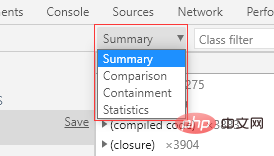
在堆快照结果页面中,我们可以使用 4 种不同的视图来观察内存情况:
- Summary:摘要视图
- Comparison:比较视图
- Containment:包含视图
- Statistics:统计视图
默认显示 Summary 视图。
Summary(摘要视图)
摘要视图根据 Constructor(构造函数)来将对象进行分组,我们可以在 Class filter(类过滤器)中输入构造函数名称来快速筛选对象。
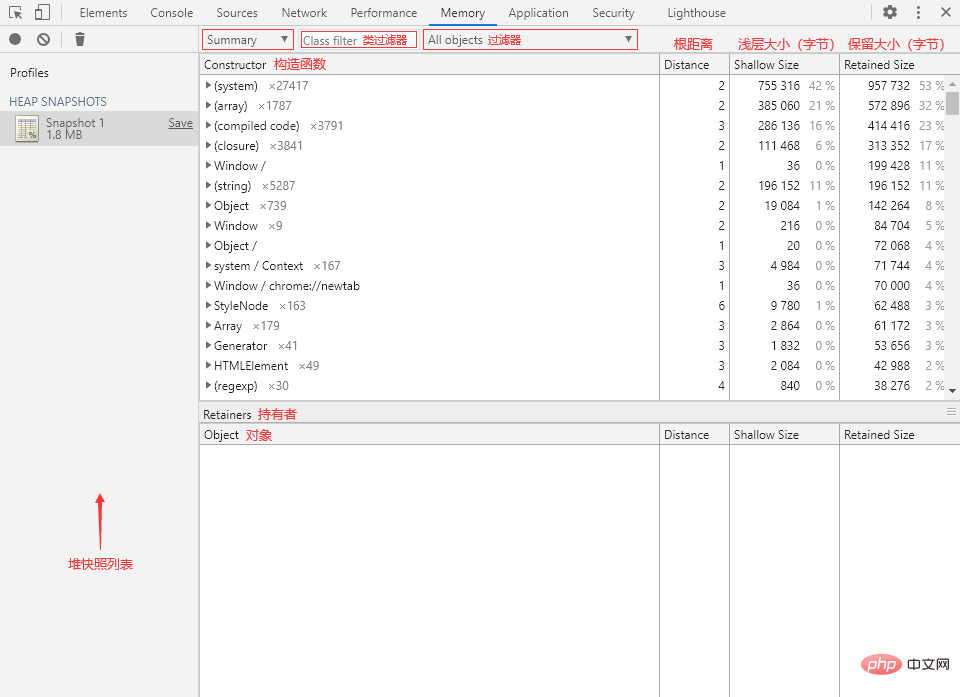
页面中的几个关键词:
- Constructor:构造函数。
- Distance:(根)距离,对象与 GC 根之间的最短距离。
- Shallow Size:浅层大小,单位:Bytes(字节)。
- Retained Size:保留大小,单位:Bytes(字节)。
- Retainers:持有者,也就是直接引用目标对象的变量。
? Retainers(持有者)
Retainers 栏在旧版的 Devtools 里叫做 Object’s retaining tree(对象保留树)。
Retainers 下的对象也展开为树形结构,方便我们进行引用溯源。
在视图中的构造函数列表中,有一些用“()”包裹的条目:
- (compiled code):已编译的代码。
- (closure):闭包函数。
- (array, string, number, symbol, regexp):对应类型(
Array、String、Number、Symbol、RegExp)的数据。 - (concatenated string):使用
concat()函数拼接而成的字符串。 - (sliced string):使用
slice()、substring()等函数进行边缘切割的字符串。 - (system):系统(引擎)产生的对象,如 V8 创建的 HiddenClasses(隐藏类)和 DescriptorArrays(描述符数组)等数据。
? DescriptorArrays(描述符数组)
描述符数组主要包含对象的属性名信息,是隐藏类的重要组成部分。
不过描述符数组内不会包含整数索引属性。
而其余没有用“()”包裹的则为全局属性和 GC 根。
另外,每个对象后面都会有一串“@”开头的数字,这是对象在内存中的唯一 ID。
小贴士:按下快捷键 Ctrl/Command + F 展示搜索栏,输入名称或 ID 即可快速查找目标对象。
? 实践一下:What is memory in javascript
① 切换到 Console 面板,执行以下代码来What is memory in javascript:
function TestClass() {
this.number = 123;
this.string = 'abc';
this.boolean = true;
this.symbol = Symbol('test');
this.undefined = undefined;
this.null = null;
this.object = { name: 'pp' };
this.array = [1, 2, 3];
this.getSet = {
_value: 0,
get value() {
return this._value;
},
set value(v) {
this._value = v;
}
};
}
let testObject = new TestClass();
② 回到 Memory 面板,打一个堆快照,在 Class filter 中输入“TestClass”:
可以看到内存中有一个 TestClass 的实例,该实例的浅层大小为 80 字节,保留大小为 876 字节。

? 注意到了吗?
堆快照中的
TestClass实例的属性中少了一个名为number属性,这是因为堆快照不会捕捉数字属性。
? 实践一下:创建一个字符串
① 切换到 Console 面板,执行以下代码来创建一个字符串:
// 这是一个全局变量 let testString = '我是吴彦祖';
② 回到 Memory 面板,打一个堆快照,打开搜索栏(Ctrl/Command + F)并输入“我是吴彦祖”:

Comparison(比较视图)
只有同时存在 2 个或以上的堆快照时才会出现 Comparison 选项。
比较视图用于展示两个堆快照之间的差异。
使用比较视图可以让我们快速得知在执行某个操作后的内存变化情况(如新增或减少对象)。
通过多个快照的对比还可以让我们快速判断并定位内存泄漏。
文章前面提到隐藏类的时候,就是使用了比较视图来快速查找新创建的对象。
? 实践一下
① 新建一个无痕(匿名)标签页并切换到 Memory 面板,打一个堆快照 Snapshot 1。
? 为什么是无痕标签页?
普通标签页会受到浏览器扩展或者其他脚本影响,内存占用不稳定。
使用无痕窗口的标签页可以保证页面的内存相对纯净且稳定,有利于我们进行对比。
另外,建议打开窗口一段之间之后再开始测试,这样内存会比较稳定(控制变量)。
② 切换到 Console 面板,执行以下代码来实例化一个 Foo 对象:
function Foo() {
this.name = 'pp';
this.age = 18;
}
let foo = new Foo();③ 回到 Memory 面板,再打一个堆快照 Snapshot 2,切换到 Comparison 视图,选择 Snapshot 1 作为 Base snapshot(基本快照),在 Class filter 中输入“Foo”:
可以看到内存中新增了一个 Foo 对象实例,分配了 52 字节内存空间,该实例的引用持有者为变量 foo。

④ 再次切换到 Console 面板,执行以下代码来解除变量 foo 的引用:
// 解除对象的引用 foo = null;
⑤ 再回到 Memory 面板,打一个堆快照 Snapshot 3,选择 Snapshot 2 作为 Base snapshot,在 Class filter 中输入“Foo”:
内存中的 Foo 对象实例已经被删除,释放了 52 字节的内存空间。

Containment(包含视图)
包含视图就是程序对象结构的“鸟瞰图(Bird’s eye view)”,允许我们通过全局对象出发,一层一层往下探索,从而了解内存的详细情况。

包含视图中有以下几种全局对象:
GC roots(GC 根)
GC roots 就是 JavaScript 虚拟机的垃圾回收中实际使用的根节点。
GC 根可以由 Built-in object maps(内置对象映射)、Symbol tables(符号表)、VM thread stacks(VM 线程堆栈)、Compilation caches(编译缓存)、Handle scopes(句柄作用域)和 Global handles(全局句柄)等组成。
DOMWindow objects(DOMWindow 对象)
DOMWindow objects 指的是由宿主环境(浏览器)提供的顶级对象,也就是 JavaScript 代码中的全局对象 window,每个标签页都有自己的 window 对象(即使是同一窗口)。
Native objects(原生对象)
Native objects 指的是那些基于 ECMAScript 标准实现的内置对象,包括 Object、Function、Array、String、Boolean、Number、Date、RegExp、Math 等对象。
? 实践一下
① 切换到 Console 面板,执行以下代码来创建一个构造函数 $ABC:
构造函数命名前面加个 $ 是因为这样排序的时候可以排在前面,方便找。
function $ABC() {
this.name = 'pp';
}② 切换到 Memory 面板,打一个堆快照,切换为 Containment 视图:
在当前标签页的全局对象下就可以找到我们刚刚创建的构造函数 $ABC。

Statistics(统计视图)
统计视图可以很直观地展示内存整体分配情况。

在该视图里的空心饼图中共有 6 种颜色,各含义分别为:
- 红色:Code(代码)
- 绿色:Strings(字符串)
- 蓝色:JS arrays(数组)
- 橙色:Typed arrays(类型化数组)
- 紫色:System objects(系统对象)
- 白色:空闲内存
Allocation instrumentation on timeline(分配时间轴)

在一段时间内持续地记录内存分配(约每 50 毫秒打一张堆快照),记录完成后可以选择查看任意时间段的内存分配详情。
另外还可以勾选同时记录分配堆栈(Allocation stacks),也就是记录调用堆栈,不过这会产生额外的性能消耗。
? 如何开始
点击页面底部的 Start 按钮或者左上角的 ⚫ 按钮即可开始记录,记录过程中点击左上角的 ? 按钮来结束记录,片刻之后就会自动展示结果。
? 操作一下
① 打开 Memory 面板,开始记录分配时间轴。
② 切换到 Console 面板,执行以下代码:
代码效果:每隔 1 秒钟创建 100 个对象,共创建 1000 个对象。
console.log('测试开始');
let objects = [];
let handler = setInterval(() => {
// 每秒创建 100 个对象
for (let i = 0; i < 100; i++) {
const name = `n${objects.length}`;
const value = `v${objects.length}`;
objects.push({ [name]: value});
}
console.log(`对象数量:${objects.length}`);
// 达到 1000 个后停止
if (objects.length >= 1000) {
clearInterval(handler);
console.log('测试结束');
}
}, 1000);? 又是一个细节
不知道你有没有发现,在上面的代码中,我干了一件坏事。
在 for 循环创建对象时,会根据对象数组当前长度生成一个唯一的属性名和属性值。
这样一来 V8 就无法对这些对象进行优化,方便我们进行测试。
另外,如果直接使用对象数组的长度作为属性名会有惊喜~
③ 静静等待 10 秒钟,控制台会打印出“测试结束”。
④ 切换回 Memory 面板,停止记录,片刻之后会自动进入结果页面。

分配时间轴结果页有 4 种视图:
- Summary:摘要视图
- Containment:包含视图
- Allocation:分配视图
- Statistics:统计视图
默认显示 Summary 视图。
Summary(摘要视图)
看起来和堆快照的摘要视图很相似,主要是页面上方多了一条横向的时间轴(Timeline)。

? 时间轴
时间轴中主要的 3 种线:
- 细横线:内存分配大小刻度线
- 蓝色竖线:表示内存在对应时刻被分配,最后仍然活跃
- 灰色竖线:表示内存在对应时刻被分配,但最后被回收
时间轴的几个操作:
- 鼠标移动到时间轴内任意位置,点击左键或长按左键并拖动即可选择一段时间
- 鼠标拖动时间段框上方的方块可以对已选择的时间段进行调整
- 鼠标移到已选择的时间段框内部,滑动滚轮可以调整时间范围
- 鼠标移到已选择的时间段框两旁,滑动滚轮即可调整时间段
- 双击鼠标左键即可取消选择

在时间轴中选择要查看的时间段,即可得到该段时间的内存分配详情。

Containment(包含视图)
分配时间轴的包含视图与堆快照的包含视图是一样的,这里就不再重复介绍了。
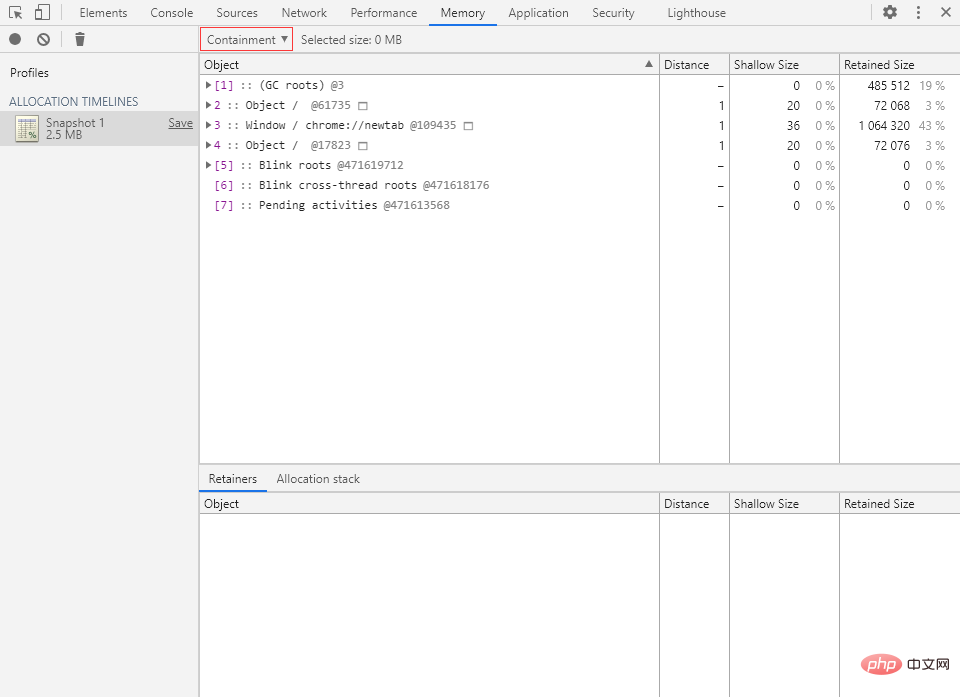
Allocation(分配视图)
对不起各位,这玩意儿我也不知道有啥用…
打开就直接报错,我:喵喵喵?
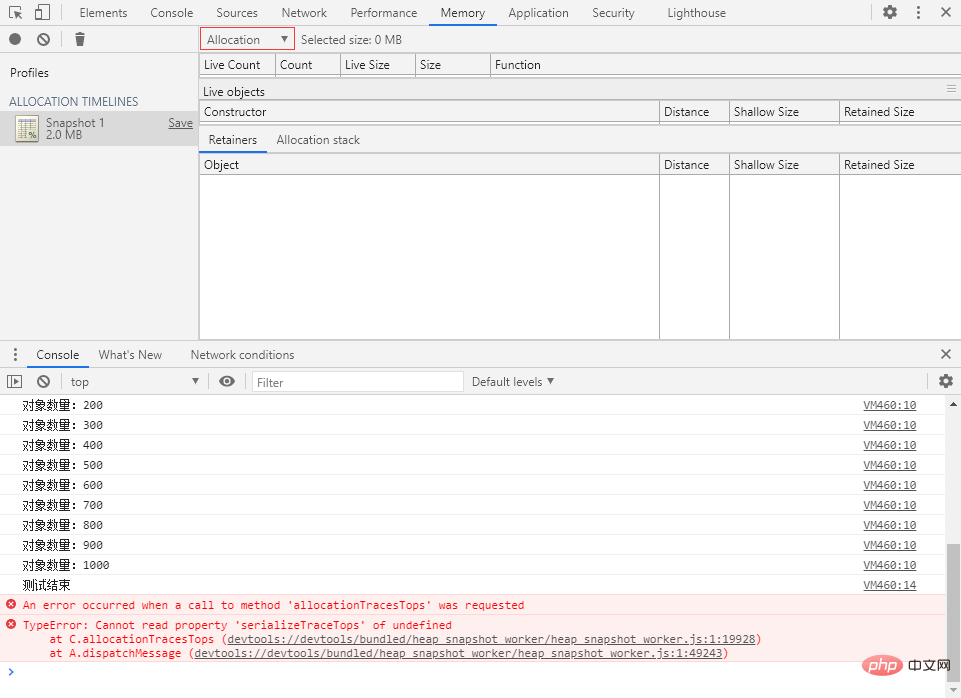
是不是因为没人用这玩意儿,所以没人发现有问题…
Statistics(统计视图)
分配时间轴的统计视图与堆快照的统计视图也是一样的,不再赘述。

Allocation sampling(分配采样)

Memory 面板上的简介:使用采样方法记录内存分配。这种分析方式的性能开销最小,可以用于长时间的记录。
好家伙,这个简介有够模糊,说了跟没说似的,很有精神!
我在官方文档里没有找到任何关于分配采样的介绍,Google 上也几乎没有与之有关的信息。所以以下内容仅为个人实践得出的结果,如有不对的地方欢迎各位指出!
简单来说,通过分配采样我们可以很直观地看到代码中的每个函数(API)所分配的内存大小。
由于是采样的方式,所以结果并非百分百准确,即使每次执行相同的操作也可能会有不同的结果,但是足以让我们了解内存分配的大体情况。
✍ 如何开始
点击页面底部的 Start 按钮或者左上角的 ⚫ 按钮即可开始记录,记录过程中点击左上角的 ? 按钮来结束记录,片刻之后就会自动展示结果。
? 操作一下
① 打开 Memory 面板,开始记录分配采样。
② 切换到 Console 面板,执行以下代码:
代码看起来有点长,其实就是 4 个函数分别以不同的方式往数组里面添加对象。
// 普通单层调用
let array_a = [];
function aoo1() {
for (let i = 0; i < 10000; i++) {
array_a.push({ a: 'pp' });
}
}
aoo1();
// 两层嵌套调用
let array_b = [];
function boo1() {
function boo2() {
for (let i = 0; i < 20000; i++) {
array_b.push({ b: 'pp' });
}
}
boo2();
}
boo1();
// 三层嵌套调用
let array_c = [];
function coo1() {
function coo2() {
function coo3() {
for (let i = 0; i < 30000; i++) {
array_c.push({ c: 'pp' });
}
}
coo3();
}
coo2();
}
coo1();
// 两层嵌套多个调用
let array_d = [];
function doo1() {
function doo2_1() {
for (let i = 0; i < 20000; i++) {
array_d.push({ d: 'pp' });
}
}
doo2_1();
function doo2_2() {
for (let i = 0; i < 20000; i++) {
array_d.push({ d: 'pp' });
}
}
doo2_2();
}
doo1();③ 切换回 Memory 面板,停止记录,片刻之后会自动进入结果页面。

分配采样结果页有 3 种视图可选:
- Chart:图表视图
- Heavy (Bottom Up):扁平视图(调用层级自下而上)
- Tree (Top Down):树状视图(调用层级自上而下)
这个 Heavy 我真的不知道该怎么翻译,所以我就按照具体表现来命名了。
默认会显示 Chart 视图。
Chart(图表视图)
Chart 视图以图形化的表格形式展现各个函数的内存分配详情,可以选择精确到内存分配的不同阶段(以内存分配的大小为轴)。

鼠标左键点击、拖动和双击以操作内存分配阶段轴(和时间轴一样),选择要查看的阶段范围。

将鼠标移动到函数方块上会显示函数的内存分配详情。

鼠标左键点击函数方块可以What is memory in javascript。

Heavy(扁平视图)
Heavy 视图将函数调用层级压平,函数将以独立的个体形式展现。另外也可以展开调用层级,不过是自下而上的结构,也就是一个反向的What is memory in javascript。

视图中的两种 Size(大小):
- Self Size:自身大小,指的是在函数内部直接分配的内存空间大小。
- Total Size:总大小,指的是函数总共分配的内存空间大小,也就是包括函数内部嵌套调用的其他函数所分配的大小。
Tree(树状视图)
Tree 视图以树形结构展现函数调用层级。我们可以从代码执行的源头开始自上而下逐层展开,呈现一个完整的正向的What is memory in javascript。
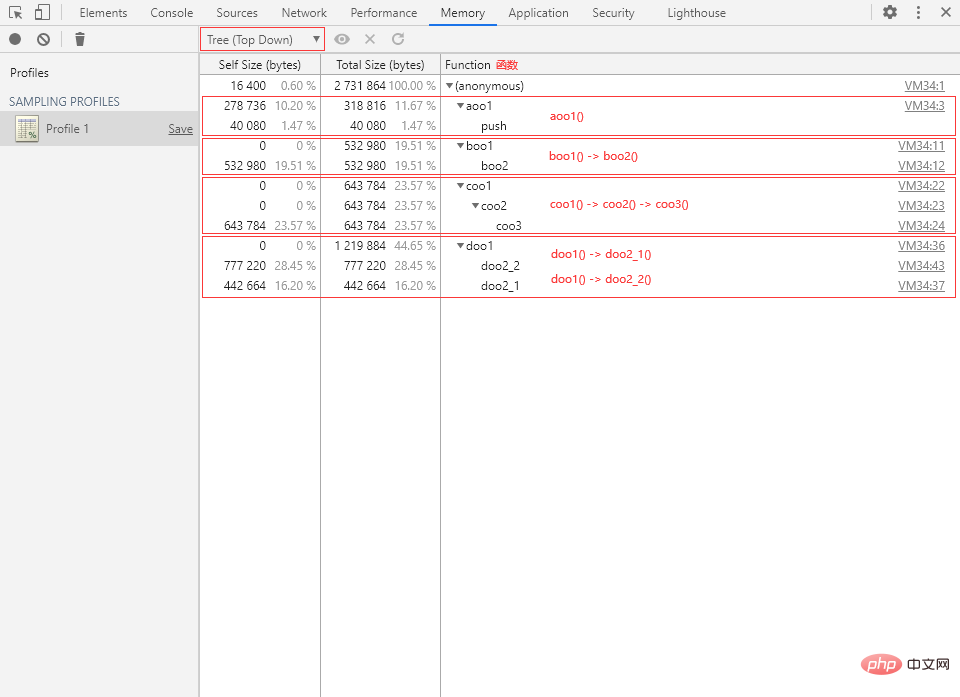
【相关推荐:javascript视频教程、编程基础视频】
The above is the detailed content of What is memory in javascript. For more information, please follow other related articles on the PHP Chinese website!

Hot AI Tools

Undresser.AI Undress
AI-powered app for creating realistic nude photos

AI Clothes Remover
Online AI tool for removing clothes from photos.

Undress AI Tool
Undress images for free

Clothoff.io
AI clothes remover

AI Hentai Generator
Generate AI Hentai for free.

Hot Article

Hot Tools

Notepad++7.3.1
Easy-to-use and free code editor

SublimeText3 Chinese version
Chinese version, very easy to use

Zend Studio 13.0.1
Powerful PHP integrated development environment

Dreamweaver CS6
Visual web development tools

SublimeText3 Mac version
God-level code editing software (SublimeText3)

Hot Topics
 1378
1378
 52
52
 Large memory optimization, what should I do if the computer upgrades to 16g/32g memory speed and there is no change?
Jun 18, 2024 pm 06:51 PM
Large memory optimization, what should I do if the computer upgrades to 16g/32g memory speed and there is no change?
Jun 18, 2024 pm 06:51 PM
For mechanical hard drives or SATA solid-state drives, you will feel the increase in software running speed. If it is an NVME hard drive, you may not feel it. 1. Import the registry into the desktop and create a new text document, copy and paste the following content, save it as 1.reg, then right-click to merge and restart the computer. WindowsRegistryEditorVersion5.00[HKEY_LOCAL_MACHINE\SYSTEM\CurrentControlSet\Control\SessionManager\MemoryManagement]"DisablePagingExecutive"=d
 How to check memory usage on Xiaomi Mi 14Pro?
Mar 18, 2024 pm 02:19 PM
How to check memory usage on Xiaomi Mi 14Pro?
Mar 18, 2024 pm 02:19 PM
Recently, Xiaomi released a powerful high-end smartphone Xiaomi 14Pro, which not only has a stylish design, but also has internal and external black technology. The phone has top performance and excellent multitasking capabilities, allowing users to enjoy a fast and smooth mobile phone experience. However, performance will also be affected by memory. Many users want to know how to check the memory usage of Xiaomi 14Pro, so let’s take a look. How to check memory usage on Xiaomi Mi 14Pro? Introduction to how to check the memory usage of Xiaomi 14Pro. Open the [Application Management] button in [Settings] of Xiaomi 14Pro phone. To view the list of all installed apps, browse the list and find the app you want to view, click on it to enter the app details page. In the application details page
 Is there a big difference between 8g and 16g memory in computers? (Choose 8g or 16g of computer memory)
Mar 13, 2024 pm 06:10 PM
Is there a big difference between 8g and 16g memory in computers? (Choose 8g or 16g of computer memory)
Mar 13, 2024 pm 06:10 PM
When novice users buy a computer, they will be curious about the difference between 8g and 16g computer memory? Should I choose 8g or 16g? In response to this problem, today the editor will explain it to you in detail. Is there a big difference between 8g and 16g of computer memory? 1. For ordinary families or ordinary work, 8G running memory can meet the requirements, so there is not much difference between 8g and 16g during use. 2. When used by game enthusiasts, currently large-scale games basically start at 6g, and 8g is the minimum standard. Currently, when the screen is 2k, higher resolution will not bring higher frame rate performance, so there is no big difference between 8g and 16g. 3. For audio and video editing users, there will be obvious differences between 8g and 16g.
 Sources say Samsung Electronics and SK Hynix will commercialize stacked mobile memory after 2026
Sep 03, 2024 pm 02:15 PM
Sources say Samsung Electronics and SK Hynix will commercialize stacked mobile memory after 2026
Sep 03, 2024 pm 02:15 PM
According to news from this website on September 3, Korean media etnews reported yesterday (local time) that Samsung Electronics and SK Hynix’s “HBM-like” stacked structure mobile memory products will be commercialized after 2026. Sources said that the two Korean memory giants regard stacked mobile memory as an important source of future revenue and plan to expand "HBM-like memory" to smartphones, tablets and laptops to provide power for end-side AI. According to previous reports on this site, Samsung Electronics’ product is called LPWide I/O memory, and SK Hynix calls this technology VFO. The two companies have used roughly the same technical route, which is to combine fan-out packaging and vertical channels. Samsung Electronics’ LPWide I/O memory has a bit width of 512
 Samsung announced the completion of 16-layer hybrid bonding stacking process technology verification, which is expected to be widely used in HBM4 memory
Apr 07, 2024 pm 09:19 PM
Samsung announced the completion of 16-layer hybrid bonding stacking process technology verification, which is expected to be widely used in HBM4 memory
Apr 07, 2024 pm 09:19 PM
According to the report, Samsung Electronics executive Dae Woo Kim said that at the 2024 Korean Microelectronics and Packaging Society Annual Meeting, Samsung Electronics will complete the verification of the 16-layer hybrid bonding HBM memory technology. It is reported that this technology has passed technical verification. The report also stated that this technical verification will lay the foundation for the development of the memory market in the next few years. DaeWooKim said that Samsung Electronics has successfully manufactured a 16-layer stacked HBM3 memory based on hybrid bonding technology. The memory sample works normally. In the future, the 16-layer stacked hybrid bonding technology will be used for mass production of HBM4 memory. ▲Image source TheElec, same as below. Compared with the existing bonding process, hybrid bonding does not need to add bumps between DRAM memory layers, but directly connects the upper and lower layers copper to copper.
 Micron: HBM memory consumes 3 times the wafer volume, and production capacity is basically booked for next year
Mar 22, 2024 pm 08:16 PM
Micron: HBM memory consumes 3 times the wafer volume, and production capacity is basically booked for next year
Mar 22, 2024 pm 08:16 PM
This site reported on March 21 that Micron held a conference call after releasing its quarterly financial report. At the conference, Micron CEO Sanjay Mehrotra said that compared to traditional memory, HBM consumes significantly more wafers. Micron said that when producing the same capacity at the same node, the current most advanced HBM3E memory consumes three times more wafers than standard DDR5, and it is expected that as performance improves and packaging complexity intensifies, in the future HBM4 This ratio will further increase. Referring to previous reports on this site, this high ratio is partly due to HBM’s low yield rate. HBM memory is stacked with multi-layer DRAM memory TSV connections. A problem with one layer means that the entire
 Lexar launches Ares Wings of War DDR5 7600 16GB x2 memory kit: Hynix A-die particles, 1,299 yuan
May 07, 2024 am 08:13 AM
Lexar launches Ares Wings of War DDR5 7600 16GB x2 memory kit: Hynix A-die particles, 1,299 yuan
May 07, 2024 am 08:13 AM
According to news from this website on May 6, Lexar launched the Ares Wings of War series DDR57600CL36 overclocking memory. The 16GBx2 set will be available for pre-sale at 0:00 on May 7 with a deposit of 50 yuan, and the price is 1,299 yuan. Lexar Wings of War memory uses Hynix A-die memory chips, supports Intel XMP3.0, and provides the following two overclocking presets: 7600MT/s: CL36-46-46-961.4V8000MT/s: CL38-48-49 -1001.45V In terms of heat dissipation, this memory set is equipped with a 1.8mm thick all-aluminum heat dissipation vest and is equipped with PMIC's exclusive thermal conductive silicone grease pad. The memory uses 8 high-brightness LED beads and supports 13 RGB lighting modes.
 Installed memory not showing up on Windows 11
Mar 10, 2024 am 09:31 AM
Installed memory not showing up on Windows 11
Mar 10, 2024 am 09:31 AM
If you have installed new RAM but it is not showing up on your Windows computer, this article will help you resolve the issue. Usually, we improve the performance of the system by upgrading RAM. However, system performance also depends on other hardware such as CPU, SSD, etc. Upgrading RAM can also improve your gaming experience. Some users have noticed that installed memory is not showing up in Windows 11/10. If this happens to you, you can use the advice provided here. Installed RAM not showing up on Windows 11 If the installed RAM is not showing up on your Windows 11/10 PC, the following suggestions will help you. Is the installed memory compatible with your computer's motherboard? in BIO




